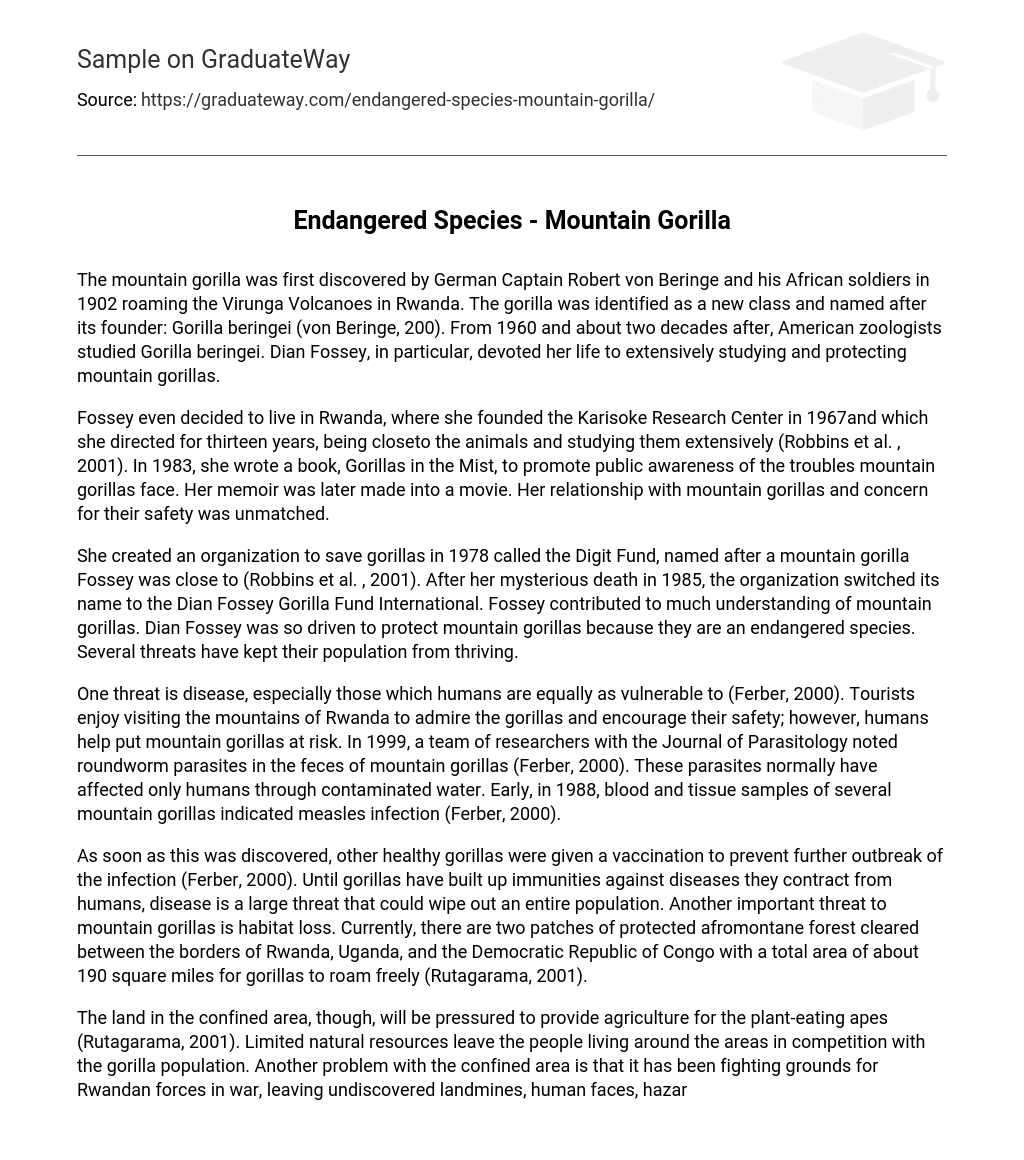The mountain gorilla was first discovered by German Captain Robert von Beringe and his African soldiers in 1902 roaming the Virunga Volcanoes in Rwanda. The gorilla was identified as a new class and named after its founder: Gorilla beringei (von Beringe, 200). From 1960 and about two decades after, American zoologists studied Gorilla beringei. Dian Fossey, in particular, devoted her life to extensively studying and protecting mountain gorillas.
Fossey even decided to live in Rwanda, where she founded the Karisoke Research Center in 1967and which she directed for thirteen years, being closeto the animals and studying them extensively (Robbins et al. , 2001). In 1983, she wrote a book, Gorillas in the Mist, to promote public awareness of the troubles mountain gorillas face. Her memoir was later made into a movie. Her relationship with mountain gorillas and concern for their safety was unmatched.
She created an organization to save gorillas in 1978 called the Digit Fund, named after a mountain gorilla Fossey was close to (Robbins et al. , 2001). After her mysterious death in 1985, the organization switched its name to the Dian Fossey Gorilla Fund International. Fossey contributed to much understanding of mountain gorillas. Dian Fossey was so driven to protect mountain gorillas because they are an endangered species. Several threats have kept their population from thriving.
One threat is disease, especially those which humans are equally as vulnerable to (Ferber, 2000). Tourists enjoy visiting the mountains of Rwanda to admire the gorillas and encourage their safety; however, humans help put mountain gorillas at risk. In 1999, a team of researchers with the Journal of Parasitology noted roundworm parasites in the feces of mountain gorillas (Ferber, 2000). These parasites normally have affected only humans through contaminated water. Early, in 1988, blood and tissue samples of several mountain gorillas indicated measles infection (Ferber, 2000).
As soon as this was discovered, other healthy gorillas were given a vaccination to prevent further outbreak of the infection (Ferber, 2000). Until gorillas have built up immunities against diseases they contract from humans, disease is a large threat that could wipe out an entire population. Another important threat to mountain gorillas is habitat loss. Currently, there are two patches of protected afromontane forest cleared between the borders of Rwanda, Uganda, and the Democratic Republic of Congo with a total area of about 190 square miles for gorillas to roam freely (Rutagarama, 2001).
The land in the confined area, though, will be pressured to provide agriculture for the plant-eating apes (Rutagarama, 2001). Limited natural resources leave the people living around the areas in competition with the gorilla population. Another problem with the confined area is that it has been fighting grounds for Rwandan forces in war, leaving undiscovered landmines, human faces, hazardous material, and weaponry to pose as threats (Rutagarama, 2001). The protected forest area, however, has been insecure for the safety of mountain gorillas during civil unrest in Africa.
After mountain gorillas were first discovered, over fifty were killed in the first two decades (Robbins et al. , 2001). A mountain gorilla can stand nearly 6 feet tall, weigh up to 400 pounds, and live an average of 50 years, but their main predators are humans (Ngowi, 2002). Poaching has been a devastating threat to mountain gorillas’ survival. Poaching is the illegal hunting of animals. Some poach for game and others for incentive, as someone may pay them to poach. Several poaching incidents have been successful, but some have not.
In January last year, for instance, an orphan mountain gorilla had been attempted to be poached, but Rwandan authorities caught two poachers in the act and arrested them before harming the animal (Sampere, 2005). The population of mountain gorillas is roughly 700 (Ngowi, 2002). Though the numbers are small, many efforts continue to be made to protect these animals and promote conservation of their habitats. As mentioned earlier, Dian Fossey’s organization and center in Karisoke still fight against the practice of poaching.
The International Gorilla Conservation Programme (IGCP) is formed by 3 international programs: World Wide Fund for Nature (WWF), African Wildlife Foundation (AWF), and Fauna and Flora International (FFI) (Ngowi, 2002). These organizations work to conserve land for mountain gorillas, promote sustainable agriculture for their diet, prevent infection from human exposure, and lessen other threats the animals face. There are various other organizations that work in collaboration with these organizations, keeping the safety and conservation of mountain gorillas in mind.





